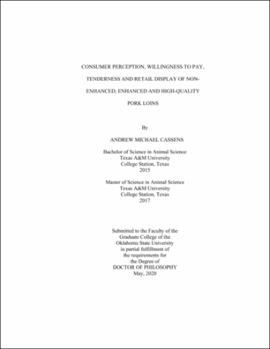| dc.contributor.advisor | Mafi, Gretchen | |
| dc.contributor.author | Cassens, Andrew Michael | |
| dc.date.accessioned | 2020-09-09T20:49:19Z | |
| dc.date.available | 2020-09-09T20:49:19Z | |
| dc.date.issued | 2020-05 | |
| dc.identifier.uri | https://hdl.handle.net/11244/325455 | |
| dc.description.abstract | The objective of this study was to evaluate the effects of three different commercially available pork loins on retail display, trained and consumer sensory panel and consumers intent to purchase. Enhanced (n = 10), non-enhanced (n = 10) and high-quality (n = 10) pork loins were selected from a commercial food distribution company. Loins were cut into 2.54-cm thick chops and randomly assigned retail display, sensory analysis, Warner-Bratzler shear (WBS) force, or instrumental data analysis. For retail display, chops were randomly assigned to 1 of 3 packaging treatments: polyvinyl chloride overwrap (PVC), carbon monoxide (CO-MAP) and high-oxygen modified atmospheric packaging (HiOx-MAP). Visual color measurement for muscle color, surface discoloration and surface color uniformity were recorded on d 0, 2, and 4 of retail display. For trained sensory panel, WBS force analysis, cook loss and Carver Press analysis, chops were evaluated at 3 different degrees of doneness (63, 68, & 74°C). High-quality loins had the highest (P < 0.05) fat % compared to enhanced and non-enhanced loins. Chops packaged in CO- and HiOx-MAP were brighter (P < 0.05) compared to PVC chops. High-quality chops packaged in PVC had the lowest a* values as well as the highest muscle color score indicative of a less reddish-pink color of lean. A greater percentage (17.8) of consumers chose high-quality pork chops first over enhanced and non-enhanced chops based on the pictures provided in the survey. For WBS force analysis, enhanced loins had lower (P < 0.05) shear values compared to non-enhanced loins. In addition, there was no difference (P > 0.05) between high-quality and enhanced, or high-quality and non-enhanced loins for WBS force values. Consumer panelist ranked the enhanced chops the highest for overall like, tenderness like and juiciness like, indicating a more tender and juicier product compared to high-quality and non-enhanced loins. In conclusion, the results suggest that enhanced, non-enhanced and high-quality pork loins available in the market have different quality parameters at retail and as a cooked product on consumers acceptability. | |
| dc.format | application/pdf | |
| dc.language | en_US | |
| dc.rights | Copyright is held by the author who has granted the Oklahoma State University Library the non-exclusive right to share this material in its institutional repository. Contact Digital Library Services at lib-dls@okstate.edu or 405-744-9161 for the permission policy on the use, reproduction or distribution of this material. | |
| dc.title | Consumer perception, willingness to pay, tenderness and retail display of non-enhanced, enhanced and high-quality pork loins | |
| dc.contributor.committeeMember | Ramanathan, Ranjith | |
| dc.contributor.committeeMember | VanOverbeke, Deb | |
| dc.contributor.committeeMember | Peel, Derrell | |
| osu.filename | Cassens_okstate_0664D_16620.pdf | |
| osu.accesstype | Open Access | |
| dc.type.genre | Dissertation | |
| dc.type.material | Text | |
| dc.subject.keywords | consumer intent to purchase | |
| dc.subject.keywords | enhanced | |
| dc.subject.keywords | high-quality | |
| dc.subject.keywords | packaging | |
| dc.subject.keywords | pork quality | |
| dc.subject.keywords | tenderness | |
| thesis.degree.discipline | Animal Science | |
| thesis.degree.discipline | Food Science | |
| thesis.degree.grantor | Oklahoma State University | |
